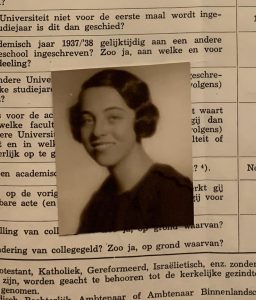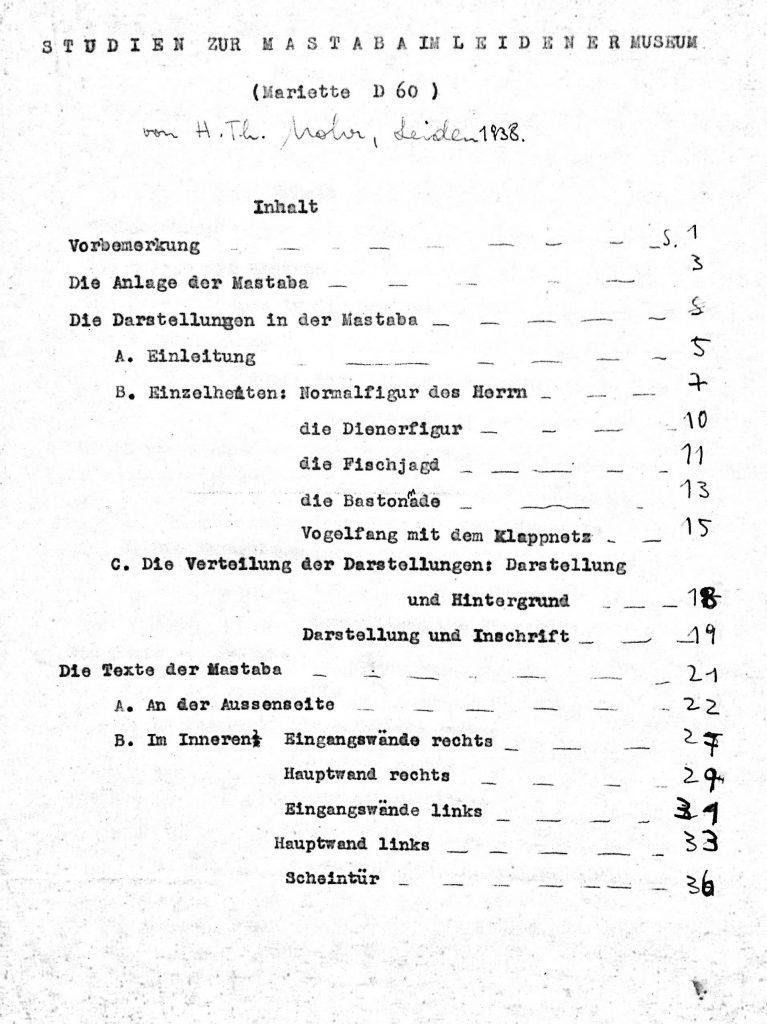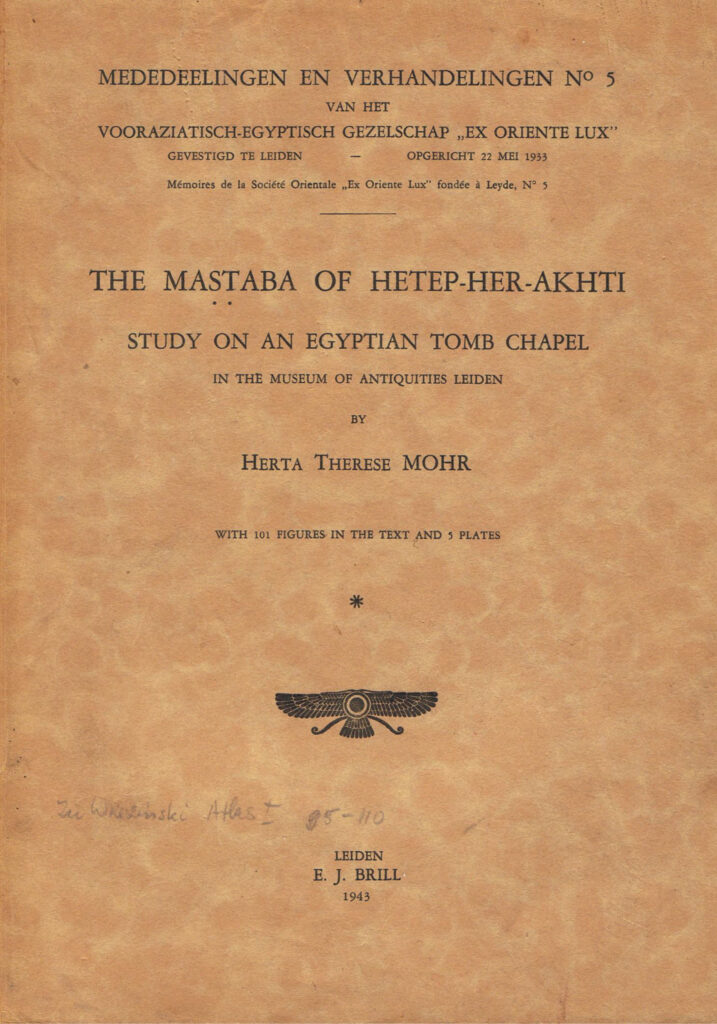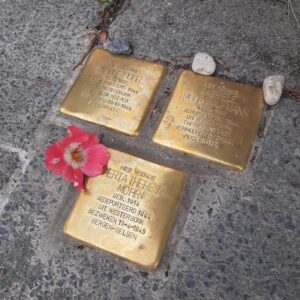
I am currently working on a biography of Herta Mohr, based on archival research, as part of my Visiting Research Fellowship at the Netherlands Institute for the Near East.
Media
- Interview: Headstrong female scientist in a man’s world
- Podcast: The Tragic Fate of Herta Mohr
- Blog: Reading a tombstone
- Dutch blog: Wie was Herta Mohr?
News
- In 2024, a Leiden University building was named after Herta Mohr!
- In 2022, Stolpersteine were laid for Herta Mohr and her parents at the Fagelstraat 17 in Leiden.
- In 2019 I started a Dutch Wikipedia page for Herta Mohr as part of a NINO project. The page is now also available in English, French and German.
Publications
- Forthcoming: Herta Mohr: Egyptoloog in Oorlogstijd, Ta Mery 2024-2025.
- Van de Beek, N., Braving the odds: Egyptologist Herta Mohr during the Second World War, in: Navratilova, H., T.L. Gertzen, M. De Meyer, A. Dodson and A. Bednarski (eds), Addressing Diversity: Inclusive Histories of Egyptology (2023), 181-203.
- Van de Beek, N., Herta Mohr and the Mastaba of Hetepherakhty, in: Verschoor, V., A.J. Stuart and C. Demarée (eds), Imaging and Imagining the Memphite Necropolis: Liber Amicorum René van Walsem (2017), 233-238.
Lectures
- Herta Mohr (1914-1945): Wenen – Leiden – Westerbork, on the occasion of the opening of the Herta Mohr building in Leiden, 8 October 2024.
- Van Wenen tot Westerbork: De academische reis van Herta Mohr, Vlaams-Nederlandse Egyptologendag, Universiteit Leiden, 14 October 2023.
- Herta Mohr: Egyptoloog in oorlogstijd, Symposium Herdenkingscultuur en de Leidse universiteit, 4 May 2018.
- Herta Mohr en de mastaba van Hetepherachet, Vlaams-Nederlandse Egyptologendag, KU Leuven, 5 November 2016.
About Herta Mohr
Herta Mohr was an Austrian Egyptologist who studied the tomb chapel of Hetepherakhty at the National Museum of Antiquities in Leiden during the 1930s. Her work was published as The Mastaba of Hetep-Her-Akhti: Study on an Egyptian tomb chapel in the Museum of Antiquities Leiden in 1943.
Herta Theresa Mohr was born in Vienna on 24 April 1914 to Adolf Emanuel Mohr and Gabriele ‘Elly’ Kaufmann. Her father was a physician who had been merited by the Red Cross for his work during the First World War. The family lived at Winckelmannstraße 2 in Vienna.
Mohr initially started studying medicine like her father, but eventually enrolled at the Faculty of Philosophy and took courses in Oriental Studies. In documents from Vienna University, her religion is listed as “mosaisch” (Jewish) and it seems she was eventually expelled for this reason.
We can then trace her steps to Leiden. In September 1938 she gave a lecture about the tomb chapel of Hetepherakhty at the 20th International Congress of Orientalists in Brussels. It was titled “Einige Bemerkungen zur Leidener Mastaba” and was accompanied by “light projections”. At the time, Herta Mohr was living at Hogewoerd 113 in Leiden.
A first draft of her study on the tomb chapel can be found in the archives of the National Museum of Antiquities. It is typewritten in German and dated to 1938. Her file furthermore contains about one hundred photographs of details of the tomb’s decoration.

Manuscript of the study (RMO archives)

Photograph of the tomb decoration, possibly made by Mohr
Mohr became a member of the Catholic student association Augustinus and was baptized as a Catholic on 13 July 1939. She continued working on the mastaba chapel of Hetepherakhty until it became inaccessible in September 1939.
According to the Gedenkboek of the Catholic academic society, she had a permit to travel to America, which she didn’t get the opportunity to use. In 1940 she moved to Eindhoven, where she apparently lived with the Van Dam family at Prins Hendrikstraat 35.
In the preface to her work, written in the summer of 1942 in Eindhoven, Mohr carefully avoids any mention of the war. She presents the book as the result of her studies between 1937 and 1940, “as circumstances allow”. Her final manuscript was worked over by Jozef Janssen and Adriaan de Buck, and edited by B.A. van Proosdij before it was published in 1943. By that time, she was already in camp Westerbork.

Shortly after having written the preface to Hetep-her-Akhti, the Eindhoven police issued Mohr’s arrest. According to the Gedenkboek, she was about to go into hiding when she was arrested early in the morning of 2 August 1942. Together with other Catholic Jews she was brought to the Westerbork Transit and Assembly Camp, and on 4 August she was interned in barrack 48.
At Westerbork, Mohr was granted deferral of transport (“Sperre”) because she worked as a translator. A highly unfortunate incident with a camp official, involving a letter containing allegations of corruption, finally caused her transport to Auschwitz on 25 January 1944. Her parents had been sent to Theresienstadt a few days earlier, but were sent on to Auschwitz at the end of October, where they were killed on arrival.

In January 1945, Auschwitz was being evacuated, due to advancing Russian forces. Part of the inmates were sent westwards via Gross-Rosen. In the hospital of Gross-Rosen, Herta Mohr was seen by someone with the same family name, but who was unrelated to her.
The place and date of Mohr’s death have been thoroughly researched, but could not be unequivocally established. Probably they were established later by a judge. According to the official records, Herta Mohr died in Bergen-Belsen on 15 April 1945, aged 30.
The tomb chapel of Hetepherakhty is currently undergoing a new study using digital recording methods, and will be published by Dr. René van Walsem and myself. It will be dedicated to the memory of Herta Mohr. You can support to the project on Patreon.
Sources
- Actes du XXe Congrès international des orientalistes: Bruxelles, 5-10 Septembre 1938 (1940), 95-97.
- Mohr, H.Th., The Mastaba of Hetep-Her-Akhti: Study on an Egyptian Tomb Chapel in the Museum of Antiquities Leiden (1943).
- Federn, W., Book review in Bibliotheca Orientalis 3 (1946), 57-9.
- Gedenkboek 1940-1945 van de Katholieke academische gemeenschap (1947), 91-92.
- Giltay Veth, D. and Leeuw, A.J. van der, Rapport door het Rijksinstituut voor Oorlogsdocumentatie uitgebracht aan de minister van Justitie inzake de activiteiten van drs. F. Weinreb gedurende de jaren 1940-1945, in het licht van nadere gegevens bezien (1976), 1310-1315.